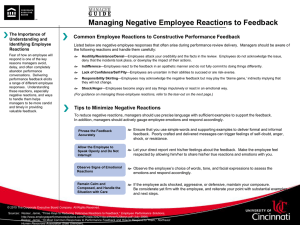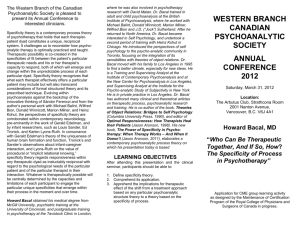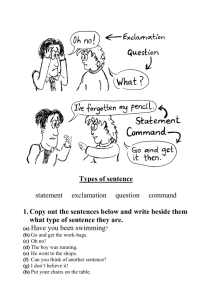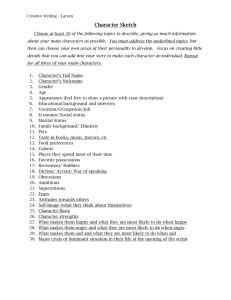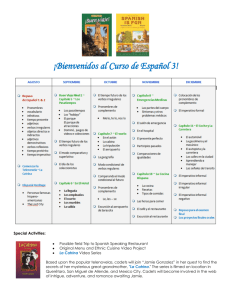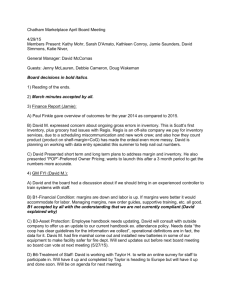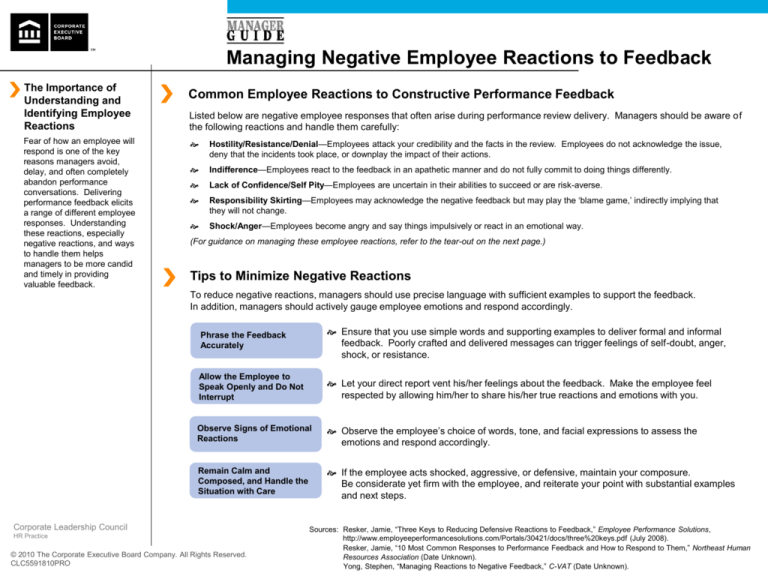
Managing Negative Employee Reactions to Feedback
The Importance of
Understanding and
Identifying Employee
Reactions
Fear of how an employee will
respond is one of the key
reasons managers avoid,
delay, and often completely
abandon performance
conversations. Delivering
performance feedback elicits
a range of different employee
responses. Understanding
these reactions, especially
negative reactions, and ways
to handle them helps
managers to be more candid
and timely in providing
valuable feedback.
Common Employee Reactions to Constructive Performance Feedback
Listed below are negative employee responses that often arise during performance review delivery. Managers should be aware of
the following reactions and handle them carefully:
Hostility/Resistance/Denial—Employees attack your credibility and the facts in the review. Employees do not acknowledge the issue,
deny that the incidents took place, or downplay the impact of their actions.
Indifference—Employees react to the feedback in an apathetic manner and do not fully commit to doing things differently.
Lack of Confidence/Self Pity—Employees are uncertain in their abilities to succeed or are risk-averse.
Responsibility Skirting—Employees may acknowledge the negative feedback but may play the ‘blame game,’ indirectly implying that
they will not change.
Shock/Anger—Employees become angry and say things impulsively or react in an emotional way.
(For guidance on managing these employee reactions, refer to the tear-out on the next page.)
Tips to Minimize Negative Reactions
To reduce negative reactions, managers should use precise language with sufficient examples to support the feedback.
In addition, managers should actively gauge employee emotions and respond accordingly.
Phrase the Feedback
Accurately
Ensure that you use simple words and supporting examples to deliver formal and informal
feedback. Poorly crafted and delivered messages can trigger feelings of self-doubt, anger,
shock, or resistance.
Allow the Employee to
Speak Openly and Do Not
Interrupt
Let your direct report vent his/her feelings about the feedback. Make the employee feel
respected by allowing him/her to share his/her true reactions and emotions with you.
Observe Signs of Emotional
Reactions
Observe the employee’s choice of words, tone, and facial expressions to assess the
emotions and respond accordingly.
Remain Calm and
Composed, and Handle the
Situation with Care
If the employee acts shocked, aggressive, or defensive, maintain your composure.
Be considerate yet firm with the employee, and reiterate your point with substantial examples
and next steps.
Corporate Leadership Council
HR Practice
© 2010 The Corporate Executive Board Company. All Rights Reserved.
CLC5591810PRO
Sources: Resker, Jamie, “Three Keys to Reducing Defensive Reactions to Feedback,” Employee Performance Solutions,
http://www.employeeperformancesolutions.com/Portals/30421/docs/three%20keys.pdf (July 2008).
Resker, Jamie, “10 Most Common Responses to Performance Feedback and How to Respond to Them,” Northeast Human
Resources Association (Date Unknown).
Yong, Stephen, “Managing Reactions to Negative Feedback,” C-VAT (Date Unknown).
Managing Negative Employee Reactions to Feedback
Common Employee Reactions to Constructive Feedback and Appropriate Manager Responses
Employee
Reaction
Sample Employee Statement
Guidelines for Manager Response
Sample Manager Response
Do:
Provide sufficient examples to support your feedback
Gauge the employee’s reasons for resistance
Ask the employee to reflect on the feedback and end the
discussion if the employee is being pointlessly resistant
Candidly discuss the consequences if the employee does not
address the development area
Refer the employee to the employee assistance program (EAP),
if appropriate
“I don’t know what you’re
talking about. I provide great
customer service!”
Hostility/
Resistance/
Denial
“I do not accept your feedback
regarding my project
management skills.
The incident you cited did not
take place.”
Don’t:
Get aggravated with the employee’s open hostility and resistance
to your feedback
Soften your feedback to alleviate the reaction
Attack the employee’s personality based on his/her reaction
“Let’s review the examples I gave of areas where I see
an opportunity for improvement.”
“Let’s give you some time to reflect on the feedback I’ve
provided and reconnect tomorrow morning.”
“This is an opportunity for you to improve your
performance. Disregarding it will continue to impact
your performance reviews down the line, as well as the
future opportunities available to you here at the
organization.”
Do:
Ask the employee to reflect on the development areas and
confirm whether he/she is able to commit to them
Discuss the consequences of denial if the employee does not
commit to improving
?
“Maybe; I’ll see what I can do.”
Indifference
“I can’t make any promises,
but I’ll try.”
Don’t:
“Sure, whatever you say.”
Corporate Leadership Council
HR Practice
© 2010 The Corporate Executive Board Company. All Rights Reserved.
CLC5591810PRO
Overlook the employee’s indifference and non-commitment
toward the feedback
Lose patience with the employee
Judge the employee for being apathetic
“I’d like you to think about what we discussed and
whether it’s something you can put the required effort
toward developing.”
“It’s important to let me know if this isn’t something you
can make a full commitment to. If you decide it’s
something you can’t do then that’s acceptable, but then
we’ll need to talk about the consequences.”
Sources: Resker, Jamie, “10 Most Common Responses to Performance Feedback and How to Respond to Them,” Northeast
Human Resources Association (Date Unknown).
Bacal, Robert, “Dealing with Angry Employees,” Work911/Bacal & Associates, http://work911.com/articles/angrye.htm
(Date Unknown).
Khanna-Salehi, Swan, “Tackling Troubling Employee Behavior,” The Department of Human Resources & The Office of
General Council (Date Unknown).
Managing Negative Employee Reactions to Feedback
Common Employee Reactions to Constructive Feedback and Appropriate Manager Responses (Continued)
Employee
Reaction
Sample Employee Statement
Guidelines for Manager Response
Sample Manager Response
Do:
Lack of
Confidence/
Self-Pity
Give the employee time alone to regain composure, if necessary
Highlight that this is an opportunity to improve
Assure the employee that improvement is possible with effort—
use past examples of his/her successful development
Reassure him/her that you will offer support
Provide examples of small steps the employee can take toward
improvement
Refer the employee to the employee assistance program (EAP),
if appropriate
“I don’t know where to start
from.”
“I knew this would happen; I
can never do anything
correctly.”
“Now that we have identified this area for development,
it is an opportunity for you to improve your performance.
I firmly believe you are capable of achieving this goal.
I’ve seen you achieve similar development goals in the
past, for example…”
“You will have support from me as you work on this. For
example…”
“Let’s talk about what you can do to improve in this
area.”
Don’t:
Focus on the employee’s past inability to achieve outcomes
Moderate your feedback to alleviate the reaction
Reflect the employee’s negative attitude
Do:
Listen to the employee’s reasons and situation
Restate the examples
Clarify that the employee will need to meet expectations and
improve the development areas despite his/her reasons
“It’s not my fault…”
Responsibility
Skirting
“I’m sorry, but when people ask
such basic questions it is very
annoying.”
?
Don’t:
Agree with the employee when he/she blames other people
Change your perspective based on the reasons or excuses if
they are not valid
Corporate Leadership Council
HR Practice
© 2010 The Corporate Executive Board Company. All Rights Reserved.
CLC5591810PRO
“I know this might be difficult for you to focus on, but the
fact remains that I need you to work productively with
your peers.”
“I know there have been a lot of changes recently, but I
still need you to support the change and increase sales
in your new territory.”
Sources: Resker, Jamie, “10 Most Common Responses to Performance Feedback and How to Respond to Them,” Northeast
Human Resources Association (Date Unknown).
Bacal, Robert, “Dealing with Angry Employees,” Work911/Bacal & Associates, http://work911.com/articles/angrye.htm
(Date Unknown).
Khanna-Salehi, Swan, “Tackling Troubling Employee Behavior,” The Department of Human Resources & The Office of
General Council (Date Unknown).
Managing Negative Employee Reactions to Feedback
Common Employee Reactions to Constructive Feedback and Appropriate Manager Responses (Continued)
Employee
Reaction
Sample Employee Statement
Guidelines for Manager Response
Sample Manager Response
Do:
“This is not fair! I always knew
you didn’t like me, but this is
unreasonable.”
Shock/Anger
“I’ve been working so hard to
meet all of my project
deadlines, and this is what I
get to hear?”
Acknowledge the fact that the employee is not satisfied with the
feedback
Prod the employee for opinion and comments
Restate examples, explain your perspective
Refer the employee to the employee assistance program
(EAP), if appropriate
Don’t:
“I was expecting a promotion
and I think I deserve it.”
Corporate Leadership Council
HR Practice
© 2010 The Corporate Executive Board Company. All Rights Reserved.
CLC5591810PRO
Attack the employee’s personality based on his/her reaction
Become defensive
Moderate your feedback to alleviate the reaction
“I can see that you are upset with these results. I would
like to hear your opinion.”
“If I understand correctly, you are angry because you feel
that I have not given you enough challenging
assignments, and that I don't have any confidence in your
abilities. Is that correct?”
“Let me explain what I think happened so you can
understand my opinion. Then we can work this out
together."
Sources: Resker, Jamie, “10 Most Common Responses to Performance Feedback and How to Respond to Them,” Northeast
Human Resources Association (Date Unknown).
Bacal, Robert, “Dealing with Angry Employees,” Work911/Bacal & Associates, http://work911.com/articles/angrye.htm
(Date Unknown).
Khanna-Salehi, Swan, “Tackling Troubling Employee Behavior,” The Department of Human Resources & The Office of
General Council (Date Unknown).

